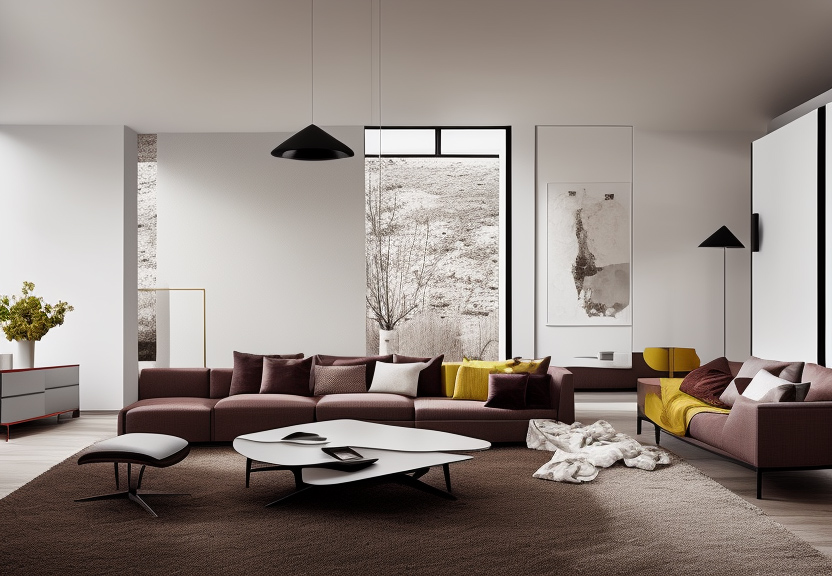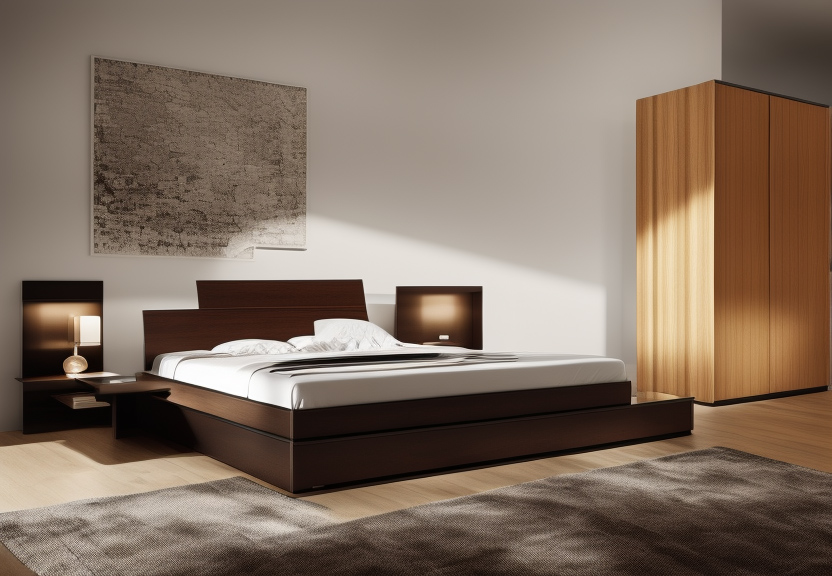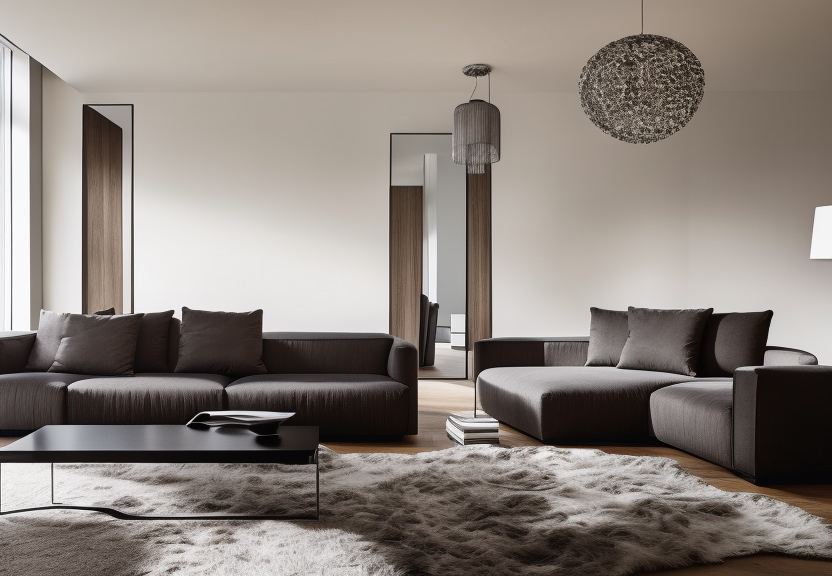As the world of interior design continuously evolves to meet the demands of our ever-changing society, so must the tools and methods used to create innovative furniture ideas. This is where Artificial Intelligence (AI) comes in. AI technology has the potential to revolutionize the way we design and create, allowing us to generate creative and innovative ideas that were previously impossible. In this blog post, we'll explore how AI can generate innovative furniture ideas and how it can help designers, architects, and builders create inspiring spaces. By understanding the power of AI, readers can gain insight into how to use this technology to their advantage and create truly unique furniture pieces.
Benefits of AI in Furniture Design
Artificial Intelligence (AI) is revolutionizing how furniture is designed and produced, offering consumers various innovative options. Through AI, designers can create unique, cost-effective pieces that match the needs of both the customer and the environment.
AI has the potential to revolutionize design by allowing for an array of customization options. Using AI, designers can create unique pieces tailored to a customer's specifications. AI can also be used to generate parts and components that are not only cost-effective but also environmentally friendly. This means customers can have a piece of aesthetically pleasing and sustainable furniture.
Another benefit of AI in furniture design is the ability to create ergonomically designed pieces. By utilizing AI, designers can design comfortable pieces and provide support and relief to those with physical disabilities. This can be especially beneficial for customers looking for furniture that is not only aesthetically pleasing but also practical and accommodating.
Finally, AI can also be used to predict trends in design. By utilizing AI, designers can quickly identify popular furniture design trends and create fashionable pieces that align with current trends. This can save time and money for designers and customers looking for the latest styles in interior home design.
In conclusion, AI is changing how modern furniture is designed and produced, offering consumers various innovative options. Through AI, designers can create unique, cost-effective pieces that match the needs of both the customer and the environment. AI can also be used to generate parts and components that are not only cost-effective but also environmentally friendly. Additionally, AI can create ergonomically designed pieces and predict design trends. As AI continues to advance, designers will inevitably be able to create increasingly innovative pieces that meet the needs of both customers and the environment.

What is AI, and how does it Work?
AI, or Artificial Intelligence, is a form of technology that mimics the cognitive functions of the human brain. It can create innovative furniture ideas using data and pattern recognition to identify trends and consumer preferences. By combining this data with innovative algorithms, AI can generate ideas for furniture pieces that are unique, stylish, and tailored to specific consumer needs. AI can also be used to explore and experiment with different combinations of materials and colors, allowing designers to create pieces that have never been seen before.
The potential of AI to generate innovative ideas is limitless. By utilizing AI, designers can create pieces that are truly unique and provide a unique experience for consumers. AI can also generate ideas for more affordable furniture designs, making it more accessible to a broader range of people. This can help to make it more affordable and help to increase consumer satisfaction. Additionally, AI can be used to create more sustainable and eco-friendly pieces, helping minimize furniture production's environmental impact.
In short, AI is a handy tool for furniture designers and can be used to create innovative and unique pieces. AI can help generate ideas tailored to consumer preferences, make for users more affordable, and help to reduce the environmental impact of furniture production. Using the latest AI, designers can create pieces that offer consumers a unique and unforgettable experience.
Advantages of AI in Furniture Design
Artificial Intelligence (AI) in furniture design offers numerous advantages. Through access to vast data, AI can create more accurate designs, resulting in a much better product. AI also helps reduce production costs, making it more affordable for customers. Moreover, using AI in design can produce much higher quality pieces, meaning customers will receive a superior product. The benefits of utilizing AI in design are numerous and noteworthy, making it a valuable tool in the industry. To find out more, read on to learn the specific advantages of AI in design.
Accessing Data: AI can access vast amounts of data for more accurate designs.

Through its access to vast amounts of data, AI can create highly accurate designs tailored to the consumer's specific needs. Not only does this mean that furniture designs are more personalized and accurate, but it also eliminates the need for costly trial-and-error processes. In this way, AI can save time and money for designers and manufacturers while also ensuring that the furniture is of the highest quality. AI's access to data also allows it to more easily identify trends in the furniture industry, enabling it to create designs that can be used to anticipate consumer needs and preferences. By leveraging its access to data, AI can create innovative designs that are both tailored to the consumer and reflect the latest trends. In this way, AI can revolutionize the furniture industry and empower designers to create more personalized, cost-effective, and innovative designs.
Cost Savings: AI can help reduce costs associated with furniture production
Through the application of AI, furniture production can benefit from cost savings. Designers can save time and money by automating the creative process and quickly finding solutions to design problems. AI can generate aesthetic and practical designs tailored to specific needs. Additionally, AI can reduce material costs by selecting materials and components that are the most cost-effective while still meeting the customer's design requirements. This cost savings can be passed on to the customer, resulting in high-quality, innovative furniture ideas at an affordable cost. An AI-generated idea could be the perfect solution for a budget-conscious customer, providing an attractive, well-designed piece of furniture that meets their needs. AI is a powerful tool for creating innovative ideas tailored to customers' needs while saving them money.
Improved Quality: AI can help produce higher-quality furniture pieces
AI can help manufacturers produce higher-quality, aesthetically pleasing, and long-lasting furniture. This can be done by using AI to analyze customer data to create designs that meet customer demands. AI can also simulate different designs and material combinations to create the most optimal design. AI can also identify potential flaws and areas of improvement in existing pieces, thus allowing manufacturers to make necessary changes to ensure a better product. AI can also help designers generate more innovative ideas that may not have been considered. This can help create aesthetically pleasing pieces but is also functional, durable, and cost-effective. AI is a powerful tool that can help create high-quality furniture pieces, making it the perfect tool for furniture manufacturers and designers.
Examples of AI-Generated Furniture Designs
Creating furniture designs with AI is becoming increasingly popular. AI-generated designs are aesthetically pleasing and designed to be comfortable and durable. AI-generated chairs are designed to be ergonomic and supportive, while tables are designed to be efficient and stylish. Finally, AI-generated beds are designed with long-lasting comfort in mind. Generated designs are revolutionizing how we think about furniture and offer a creative, efficient, and stylish way to decorate any home. Read more to learn about the full scope of generated designs and how they can benefit your home.
Chair Design: AI can design chairs that are comfortable and ergonomic

AI technology can create chairs designed to be comfortable and ergonomic, considering individual body types, shapes, and sizes. With AI-generated designs, consumers can find a chair perfect for their body and physical needs, regardless of height, weight, or body type. In addition, AI-generated designs can make the furniture industry more efficient and cost-effective, allowing furniture makers to create great and comfortable chairs while reducing manufacturing costs. AI-generated designs are a revolutionary step forward in the furniture industry, providing consumers with the perfect chair that fits their needs and the industry with cost-savings and efficiency.
Table Design: AI can design tables that are efficient and stylish

AI-generated furniture designs, such as table designs, are revolutionizing how we create, store, and use furniture. The designs are efficient and stylish and give us a unique opportunity to have furniture tailored to our needs. AI-generated tables, for example, can be designed to fit into any space, no matter how small or large, allowing us to make the most of our living space. This technology is particularly relevant for those who live in small spaces or who require custom furniture solutions. AI-generated designs bring a unique and creative approach to furniture making, allowing us to explore new possibilities and find stylish, functional, and aesthetically pleasing solutions.
Bed Design: AI can design beds that are comfortable and long-lasting

The ability of AI to design beds that are both comfortable and long-lasting is a reflection of the ever-growing sophistication of machine learning. By leveraging the latest neural networks and algorithms, AI designs offer precision, accuracy, and efficiency that would be impossible to achieve by hand. This is particularly relevant to readers looking to invest in quality furniture they can rely on for years. As AI technology advances, its potential to create more innovative, personalized designs is fascinating.
Challenges of AI-Generated Furniture Designs
The use of AI in furniture design poses several unique challenges. These challenges can be daunting, from the high upfront cost required to utilize AI effectively to the complexity of AI designs. Considering how an AI-generated design will fit into existing designs is also essential. It is essential to consider how the AI-generated design will blend with existing designs and the practical implications of this integration. These challenges highlight the importance of employing AI in furniture design thoughtfully and responsibly. Please read on to learn more about the challenges of AI-generated designs.
Cost: AI requires a high upfront cost to be used effectively
The cost of using AI to generate furniture designs is a significant challenge for many businesses. The initial investment can be high, but it is necessary to be able to use AI in the design process effectively. AI can be used to analyze customers' preferences and create custom designs that are tailored to them. This allows for much more efficient design processes and can save businesses time and money in the long run. However, the high upfront cost can be a deterrent for some businesses, particularly smaller ones. It is essential to weigh the cost of implementing AI against the potential benefits that it can bring. For businesses willing to invest, AI designs can set them apart from their competitors and provide a valuable tool to help them create furniture that meets their customer's needs.
Complexity: AI designs can be complex and difficult to understand
The complexity of AI furniture designs can be both a blessing and a curse. On the one hand, it allows us to create creative, sophisticated designs that may never have been possible. On the other hand, it can be challenging for designers to understand and interpret the results generated by AI. This complexity can be a stumbling block for designers, as making sense of the many complex variables and algorithms used by AI systems can be challenging. Furthermore, designers may struggle to find ways to implement AI-generated designs into practical, functional furniture. Ultimately, this complexity can limit the potential of AI-generated designs, as it can be difficult for designers to make sense of them. Therefore, they must understand the complexities of AI-generated designs to maximize their potential.
Integrating with Existing Designs to be successful.
AI-generated designs offer a unique perspective on furniture that has never been seen before. The challenge lies in integrating these designs with existing designs to make them successful. This is critical to ensure that these designs do not disrupt existing furniture trends but enhance them. Furthermore, it is necessary to ensure that these designs are compatible with existing pieces to be used together to create an aesthetically pleasing overall look. This is especially relevant for the readers of this blog, as it is essential to make sure that the designs they choose for their homes are visually appealing and compatible with their existing pieces. AI-generated designs offer the unique potential to bring something new and innovative to the home decor scene. Still, it is up to the designers to ensure these pieces fit into an existing design scheme.
Conclusion

AI technology offers a range of advantages when it comes to furniture design, including cost savings, improved quality, and access to vast amounts of data. For example, AI can help design chairs that are comfortable and ergonomic, tables that are efficient and stylish, and beds that are comfortable and long-lasting. However, despite AI's potential benefits, some challenges are associated with the technology. These include costly upfront costs, the complexity of designs, and the need for AI-generated designs to integrate with existing designs. Nonetheless, the potential benefits of AI in furniture design make it an attractive option for designers, providing an efficient and effective solution for creating pieces.
In conclusion, the potential of AI-generated designs cannot be overstated. By introducing the creative design process to an AI system, we can now access thousands of innovative ideas that can revolutionize design and how we furnish our homes. As technology continues evolving and advancing, we expect to see more AI-generated designs that will be functional and aesthetically pleasing. As consumers, we can look forward to even more creative and unique pieces tailored to our preferences. We live in a world where AI-generated furniture designs are possible but also practical and attractive. It is an exciting time for design, and we can only imagine the future.




